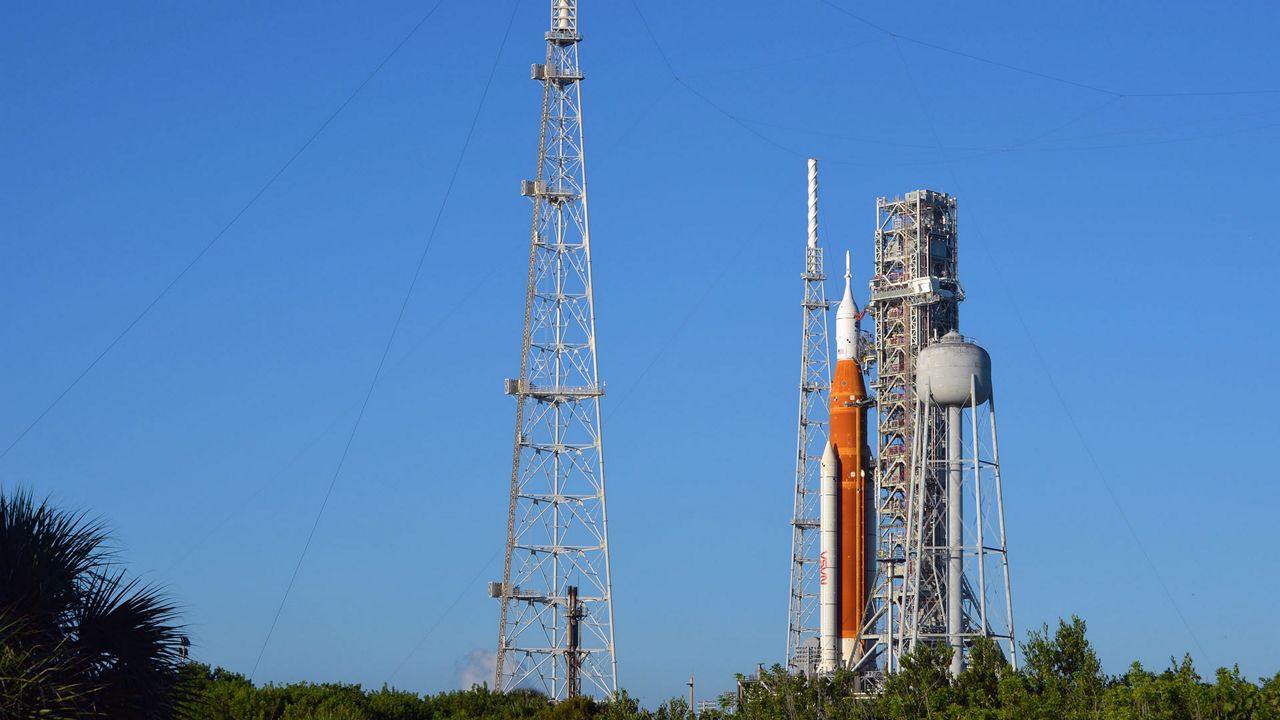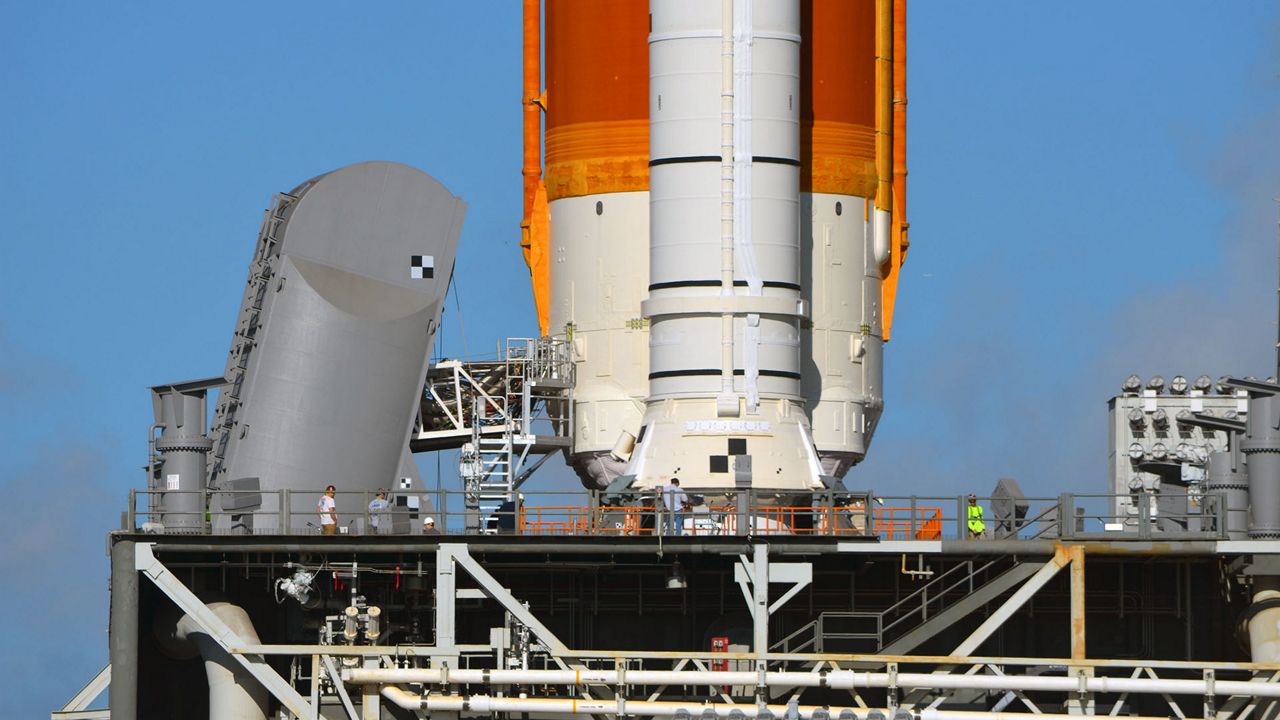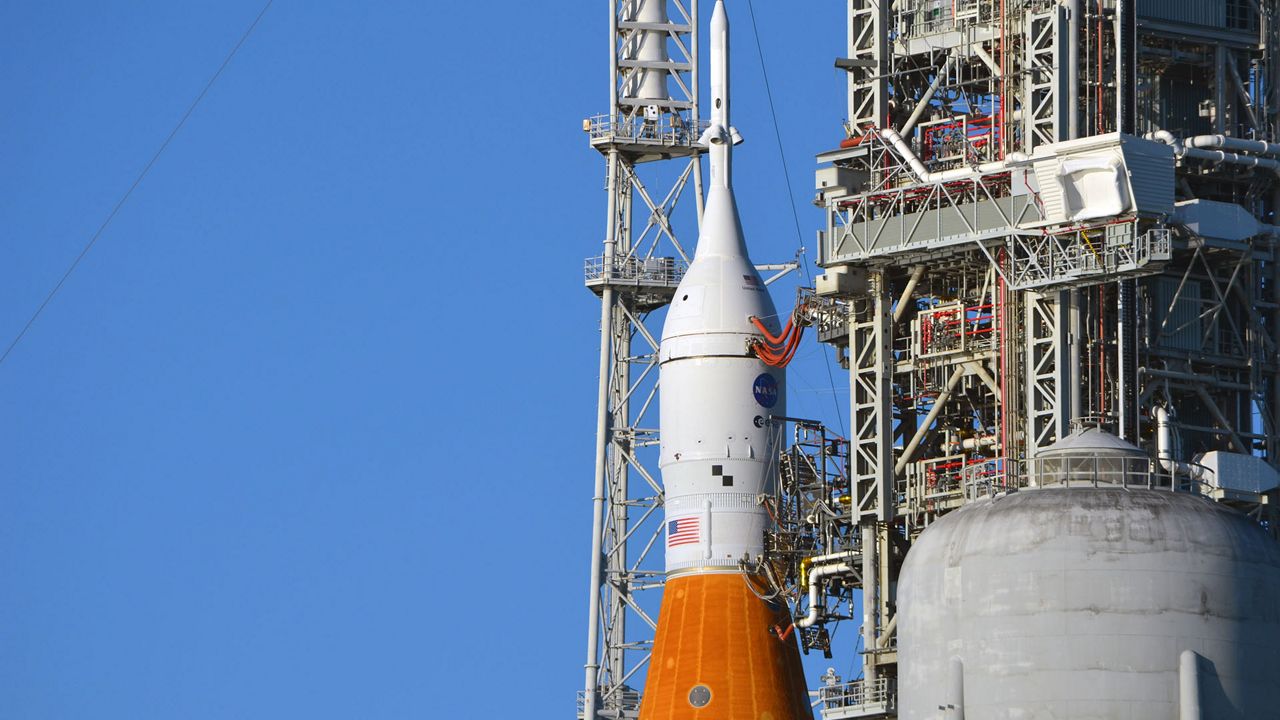The path forward for NASA’s Artemis I mission could very well take it from one holiday to another.
As of Labor Day, the Space Launch System (SLS) rocket and Orion spacecraft remain on the launch pad at Launch Complex 39B (LC-39B) while teams across NASA figure out how they will be able to launch the pivotal mission following two scrubs last week.
What You Need To Know
- The ground systems team is expected to meet with the Artemis mission management team this week to discuss options for work on the rocket
- A “large hydrogen leak” forced the launch team to back down from its second launch attempt on Sept. 3
- Teams are assessing if and when the Space Launch System rocket and Orion spacecraft will need to return to the Vehicle Assembly Building
- A new launch date for the Artemis I mission has yet to be determined
- Scroll down to view the photo gallery of Space Launch System rocket and the Orion spacecraft
- RELATED coverage: Another failed attempt: Next week's launch of Artemis I off the table
A NASA spokesperson told Spectrum News that the ground systems team would be meeting this week with the mission management team to discuss what their options are and how they want to move forward.
Artemis Launch Director Charlie Blackwell-Thompson made the call to stand down at 11:17 a.m. EDT on Saturday, Sept. 3, after technicians were unable to remedy what was described as a “large leak” of liquid hydrogen near the bottom of the rocket.
The area of concern is at the 8-inch quick disconnect (QDC), which is an umbilical used to transfer liquid hydrogen (LH2) from nearby storage tanks into the 130.8-foot-tall tank inside the SLS core stage.
The issue became apparent when the launch team moved “from the slow fill to the fast fill.”
That core stage tank has a capacity of 537,000 gallons of LH2, which is kept at -423 ℉. During Saturday’s launch attempt, they were only able to load 11% of the tank’s capacity before they called it off.
Following the scrub, NASA Administrator Bill Nelson said they will be deliberate throughout this launch campaign.
“We do not launch until we think it’s right and these teams have labored over that,” he said. “So, I look at this as part of our space program, of which safety is the top of the list.”
The holiday weekend scrub was the second in less than a week for the Artemis program, which attempted the first fully integrated launch of the SLS and Orion on Monday, Aug. 29.
Jim Free, the associate administrator of Exploration Systems Development Mission Directorate, said that Saturday’s hydrogen leak issue, which became insurmountable, was different from what they faced last Monday.
“The confidence to do another launch attempt was born out of the fact that we understood the hydrogen leaks that we had on Monday — those are different than the leak that we had today,” he said. “In terms of scale, one was in the same place, but was a different signature.”

Pad departure time pending
One of the key questions that NASA is working through at this point is when they will roll the 322-foot SLS rocket and Orion spacecraft back to the Vehicle Assembly Building (VAB).
An important factor driving the return to the VAB is the batteries operating the rocket’s flight termination system. Those can only be replaced inside the VAB and not at the pad.
Space Force’s Space Launch Delta 45 has oversight of the Eastern Range (the large area from which rockets in Florida launch) and experts need to validate the batteries and the system before they can attempt another launch.
“We do not have an agreement with the range that we can launch when our batteries have not been tested after 25 days,” Free said. “So, in order to change them out, we have to go back.”
NASA previously negotiated with the Eastern Range to extend the limitation on battery replacement to extend from 20 to 25 days. That allowed them the full duration of the Aug. 23-Sept. 6 launch period.

This week, teams are determining how long they should remain at the pad and what work they want to do there versus back in the VAB.
Mike Sarafin, the Artemis mission manager, said during a Sept. 3 press conference that if the teams stay at the pad for a while, they would need to create an environmental enclosure so that they can remove and replace “the soft goods on the quick disconnect at the pad, followed by a cryo test.”
“There’s a risk vs. risk trade — if we do it at the pad, you’re exposed to the environmental conditions," Sarafin said. "We would need to build an environmental enclosure to do that.
“If we do it in the Vehicle Assembly Building, the Vehicle Assembly Building is the environmental enclosure. However, we cannot test this quick disconnect in the VAB at cryogenic temperatures — we can only do it at ambient temperatures.”
Free added that another potentially limiting factor is the Orion spacecraft. Without going into specifics, he said that there were some constraints on how long it could remain at the pad considering the impacts of the wind.

If rolling back to the VAB is determined to be necessary, officials say they want to be deliberate with each one of those movements. Prior to Saturday’s launch, SLS Program Manager John Honeycutt said that the rocket is capable of tanking cycles that extend into the double digits.
“As far as worrying about things with the rocket sitting at the pad, there are probably more little things, like we’re seen cracks in the TPS (thermal protection system) and that sort of thing that we have to go analyze to clear,” Honeycutt said. “But the big thing we want to avoid is rollbacks to the VAB. Those are the things that Dr. (John) Blevins told me put more stress on the vehicle than anything else.”
“Now, that said, we’ve still got rolls left in the vehicle, but we want to watch that and manage it,” he added.
September, October or beyond?
Free noted on Sept. 3 that targeting a new mission date during either launch period 26 (Sept. 19–Oct. 4) or launch period 27 (Oct. 17-31) depends on the extent of the work needed for the team to feel comfortable with launching.
There are 14 and 11 launch attempts during LP 26 and LP 27 respectively, but that includes several carve-out dates when NASA cannot launch (marked with grey in the PDF). Dates that are red indicate a constraint for the Orion spacecraft, like eclipse periods where Orion’s solar arrays can’t get continuous solar power.
The light green dates are ones that allow for a short mission (26-28 days). NASA officials have previously stated that the long-duration missions (dark green/38-42 days in the PDF found below) are preferable to give Orion a thorough test.
If NASA does decide that they have to roll the rocket back to the VAB, Sarafin said the timing of that would also be a key indicator of when they could attempt another launch.
“We would also have to assess why did we roll back to the Vehicle Assembly Building," he said. "Did we just simply not get lucky with weather and we had to roll back and check out the flight termination system again? Or was it a technical issue that requires access to a very specific part of the rocket?
“We would have to look at how long does it take to gain access, the availability of spare parts or any other reason that we would’ve rolled back.”
Free said this period is reminiscent of the so-called “Summer of Hydrogen” in 1990 where hydrogen leaks plagued the Space Shuttle program, following nine years of launching previously.
“I think we’re trying to dial this vehicle in," Free said on Sept. 3. "Whatever this fault was, we have to find out and we will run it to the ground and guild that confidence that I talked about earlier to come out there again.
“If the team says, ‘Hey, a wet dress is the way to go,’ then we need to figure that out. But right now, from my perspective, we’ve tested this — it’s worked a couple of times and it didn’t today. We’ll figure out the reason why.”



